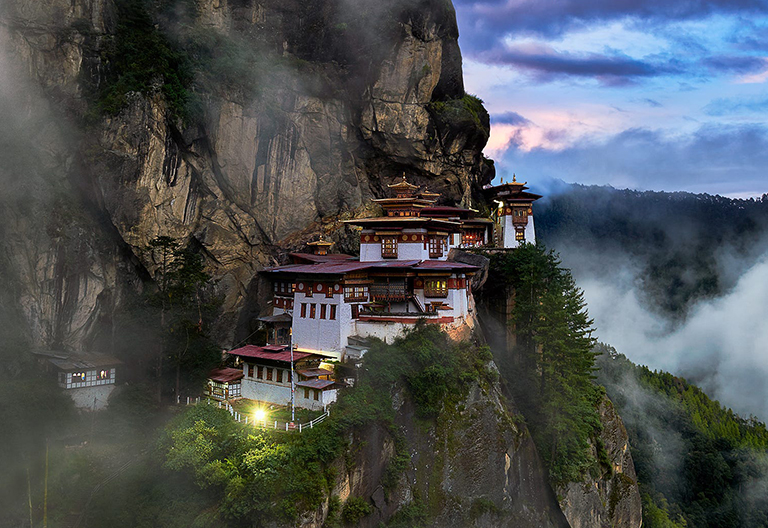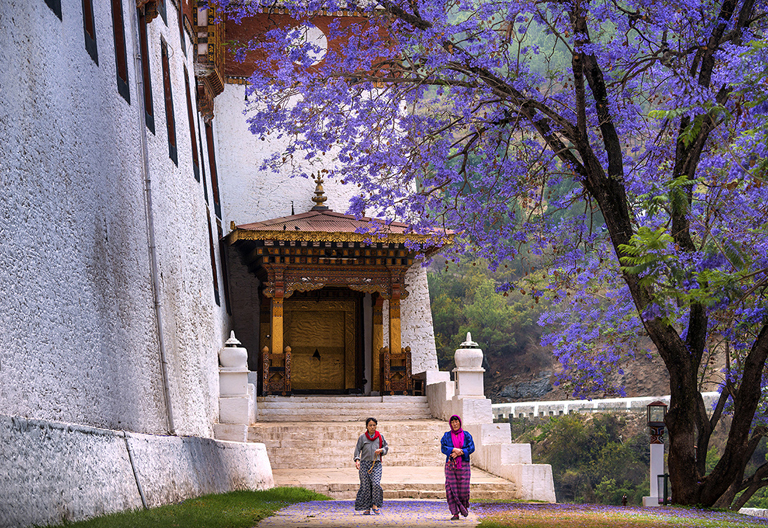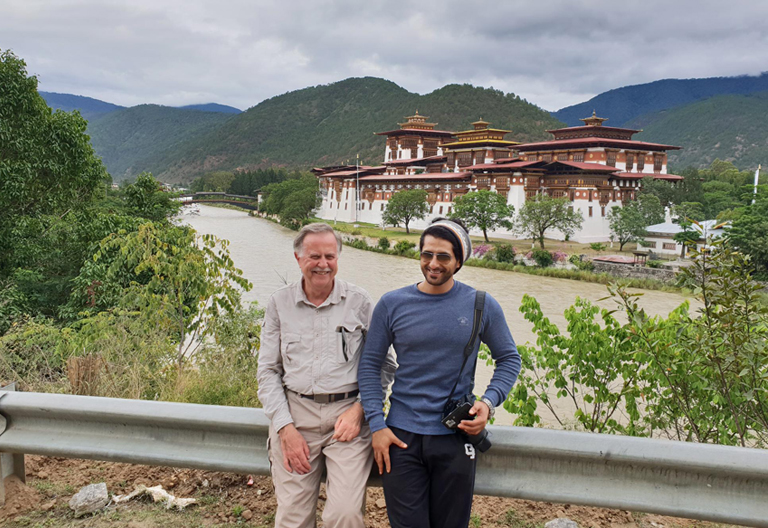Best Bhutan Places to Visit | Top 11 Bhutan Tourist Spots 2025/2026
14 September 2022 Last updated at 14:30
Bhutan, well-known as Land of the Thunder Dragon, is a picture-book Himalayan Kingdom holding many surprises. As a country based on Buddhism, Bhutan attaches great importance to nature-protecting and well-beings. They never focus on developing economy at the cost of damaging environment. Besides, old tradition and customs are carefully preserved, which distinguishes it from other countries. Due to its pristine nature and harmonious society, Bhutan gets a reputation of the last Shangri-La and becomes a lodestone for thousands of visitors. Being a unique country both environmentally and culturally, Bhutan offers many places to visit.
In Bhutan, you can easily see a fortress-like building which soars high. It is dzong, which is the site of government and monastic body. Different dongs have their own features. Visiting Bhutan, you can’t miss Paro Dzongs, Punakha Dzongs, Trongsa Dzongs etc. It is also worthwhile to pay a visit some monasteries of lhkhangs, like Taktsang Monastery, Kyichu Lhakhang, Jampery Lhakhang ans so on. Besides the cultural attractions in Bhutan, the natural scenery will also give you a pleasant journey. Check the top travel destinations and attractions in Bhutan.
Paro – Tourist Distribution Center
Located in western Bhutan and owning Bhutan’s only international airport, Paro is mostly regarded the first destination in Bhutan. The attractive town of Paro is on the two banks of Paro Chhu (River), with a short distance of 3km to grand Paro Dzong. In Paro, you can visit many historical and Buddhist sites.
Taktsang Monastery – Landmark of Bhutan
Taktsang Monastery (known as the Tiger’s Nest Monastery) is the holiest Buddhist monastery in Bhutan, also one of the Ten Most Magical Monasteries in the World. Highly hanging to the cliff about 3,900m (2,953ft) bellow the earth, it is an architectural wonder. It goes a legend about how Tiger’s Nest Monastery was built. The Guru Rinpoche has flied to the site on a tiger and vanquished a devil called Singey Samdrup. Then Guru Rinpoche has mediated there for three months. This place has long been recognized as a holy place. In the following years, many famed Buddhists came here for mediation. In 1692, Taktsang was constructed. With its Buddhist significance and architectural magic, it is the landmark and symbol of Bhutan.
Visiting Taktsang Monastery, you need to trek about several hours which is really worthwhile. From the cafeteria on the road and viewpoint near the monastery, you can savor a breathtaking view of the monastery. In the monastery, you are able to visit Guru Rinpoche’s mediating cave – Dubkhang with a permit. The monastery is also collected with many vivid statues and delicate Buddhist murals.

Taktatsang Monastery

Road to Taktatsang Monastery
Rinpung Dzong – Bhutan’s Most Classic Architecture
Perched in the upper Paro Valley, Rinpung Dzong will catch your eyes no matter you are in which corner of the valley. The full name of Rinpung Dzong is Rinchen Pung Dzong which literally means Fortress on a Heap of Jewels. It was built on the site of an old monastery constructed by Guru Rinpoche. In the history, Rinpung Dzong played an important role to defend Paro valley from invasion, so many people call Paro Dzong. Rinpung Dzong, as well as other dzongs in Bhutan, is the venue of both monastic body and local government.
Paro Dzong can be divided into two parts (so as most other dzongs), the front administrative section and the back monastic section. The highlight in the dzong is a small Lhakhang in the east Dzong, which houses an 11-headed manifestation of Chuchizhey. Here you can admire the gorgeous wooden carve, colorful decorations, as well as soaring white walls. Out of the Dzong, you can find a stone-paved area where traditional dances will be performed during Paro’s Tsechu Festival.
On the top of Paro Valley (above Rinpung Dzong) stands an ancient watchtower, which houses Bhutan’s National Museum of Bhutan. The collections displayed in different exhibiting hall are deeply memorable, including various thangkas, statues, murals, carvings etc. Tourists usually take a tour combing Rinpung Dzong and National Museum.

Rinpung Dzong
Kyichu Lhakhang – One of the Most Ancient Monasteries
It is said that Songtsen Gampo (a King of Tibet) has built twelve temples to suppress a wild demoness who aimed to thwart the propagation of Buddhism. Kyichu Lhakhang was built to pin down the demoness’ left foot in 659, and famous Jokhang Temple was built on her heart. 1,000 years later, more architectures and the golden roof was built.
When you enter the inner courtyard of Lyichu Lhakhang, you can see a mural on the left corridor describing the story of King Gesar. The queen of the third Wangchuk King donated to build Guru Lhakhang, where a 5-meter high statue of Guru Rinpoche is worshipped. The main hall in Kyichu Lhakhang is Jowo Lhakhang which conceals the greatest treasure of the valley. It is a statue of Sakyamuni said to be made at the same with the construction of the life-sized statue of the Shakyamuni at the age of 12. In the front of the statue, there is a groove on the ground that numerous pilgrims have worn into.

Kyichu Lhakhang
Thimphu – Most Relaxing Capital in the World
Thimphu is Bhutan’s capital and largest city, it share little in common with other countries’ capitals. It’s not modern and prosperous, but rather col-lg-5relaxing and peaceful. As the major city of Bhutan, there are also many worth-visiting sites.
National Memorial Chorten – Center for Pilgrims
National Memorial Chorten was built to in memory to the third King in 1974. Now, it is the center of daily pilgrimage for local people. It is believed that kora around the stupa can wash off all the sins. When the local people pass through National Memorial Chorten, they will make a kora to show respect.
With whitewashed body and golden National Mmorial is the most brilliant religious building in Thimphu. The surrounding is four bright affiliated architectures, exquisite mandala, statues and a shrine. More than a memorial Chorten, it is a Buddhist stupa and many precious religious paintings and Buddhist images are cherished in inside.

National Memorial Chorte
Weekend Market – Bhutanese Real Life
If you happen to visit Thimphu on weekends, you can’t miss Weekend Market. Just as its name signifies, Weekend Market is only open on weekends. The market is on the two banks of Wang Chhu – the western area is for selling food material and the eastern is for daily articles and souvenirs. In the food area, you can see dried fish, pork, yak meat, homemade cheeses etc. In addition, you may also spot some banana pods, nakey, red rice and Tsam-pa. Tsam-pa is usually beloved by highland Bhutanese and Tibetans. You may also see lots of dried or fresh chilllies – they are not ingredients but staple food. Cross the footbridge above the fast-flowing river to get to the western stalls, and you will enjoy reams of handicrafts.
In fact, Weekend Market is not only a market for shopping, but a social occasion. Most Bhutanese will wear their traditional clothes, boys on Ghuo and girls on Kira. Therefore, Weekend Market is a good place to experience the local life. Paro also has it Weekend Market, but Thimphu’s Weekend Market is much lively.

Weekend Market
Motithang Takin Preserve – Residence of Bhutan’s National Animals
Motithang Takin Preserve is a protect zone of Takin, Bhutan’s National Animals. It was a zoo original, but disbanded by the fourth king because he thought it went against Bhutan’s environmental and Buddhism conviction. However, the takins are too tamed to leave Thimphu, so the Takin Preserve was designed to protect them. Takin is a truly unique creature which can’t be seen anywhere else. It looks like something something between a cow and a goat. Visit Motithang Takin Preserve in the morning, so you can see more takings strolling around.

Takin
Dochula Pass – Viewpoint for Himalayan Range
With an elevation of 3,140m (10,302ft), Dochula Pass offers a breathtaking sight of the surrounding landscape. As your car ascends to Dochula Pass, you will firstly see the Wangchuk Memorial Chorten – a group of 108 Buddhist stupas. These stupas were built to memorize the warriors who have expelled the invaders. There are holy relics in every stupa, and anyone who steals the relics will be sentenced to life imprisonment. The arrays of colored Buddhist flag prayers fly in the wind. When the weather is good, tourist can see Himalayan Ranges clearly. The blue sky was kissing the mountains in the horizon, the greenery all the way gives you the realization what nature is.
Apart from these attractions, Thimphu also owns many museums and institutes. Museums include Folk Heritage Museum showing the construction of the traditional farmhouses, National Textile Museum mainly exhibiting the dancing costumes and processes of making textile, Simply Bhutan – a museum offering interactive activities to the youth etc. The institutes are also open to visitors, including National Institute for Painting, Natinal Institute of Traditional Medicine etc.

Dochula Pass
Punakha – Livable Paradise
Located in the fertile valley with lower altitude, Punakha enjoys spectacular rural scenery. The royal family and monastic body will move from Thimphu to Punakha in every winter because of the warmer climate there. Punakha is riched in rice and some fruits like Banana and oranges. It’s exaggerating to say Punakha is the barn of Bhutan. Before Thimphu, Punakha has been the capital city for 300 years.
Punakha Dzong – Most Beautiful Dzong in Bhutan
If you just want to visit one dzong in Bhutan, it must be Punakha Dzong. Legend has it that the honored Guru Rinpoche predicted Saint Namgya’s visit to the elephant-shaped hill (in Punakha). A man called Namgya did come and created Punakha Dzong. Thanks to its perfect location of the junction of two rivers, Punakha Dzong is nourished with glamorous surrounding nature. When the purple blue jacaranda flowers bloom in April, rivalling the red-and-white palace and saffron-colored robes of the monks, you may wonder whether you step into the paradise.
Unlike any other dzongs, Punakha has an additional dochey apart from administrative area and monastic area. The third dochey is shrined the statues of Guru Rinpoche and Namgya. The remains of Namgya are also worshiped in the hall of Machey Lhahang. No one is allowed to visit Machey Lhakhang expect for the king and the monastic leader. There are also marvelous murals which tell the story of the Buddha.

Beautiful Punakha Dzong
Chimi Lhakhang
Chimi Lhakhang is perched on a small hill of Meshine Valley. It was built by the cousine of Lama Drukpa Kunley in his honor of defeating the demoness in Dochula Pass. A wooden statue of Lama Drukpa is erected in Chimi Lhakhang, and the childless women will come here to get a blessing from him. When their babies are born, they will be brought here to get a name. But all of them use the same name – chimi. In the inner hall, visitors are forbidden to take photos, but you can take picture of the surrounding rural scenery.

Monks in Chimi Lhakhang
Trongsa – Central Heart of Bhutan
Trongsa is located at the heart of the territory of the Kingdom of Bhutan. In fact, it is also the center in the history. Its highlighted Trongsa Dzong and the surrounded towns are at the upper valley, which provides great views of the whole Valley.
Trongsa Dzong
Trongsa Dzong enjoys a long history which can be traced back to 16th century. In the history, it held an important strategic location. The road connecting eastern and western Bhutan runs through Trongsa and used to pass through the Dzong itself. The first and second kings of Bhutan both reigned over the country. Till now, all the crown princes have to serve as Penlop of Trongsa before becoming the kings.
There are 23 independent lhakhangs in Trongsa Dzong, and all of them are delicately-decorated. Many decorations were made during the reign of the first king. What you can’t miss are the North Hall and southern Mithrub Lhkang. The stupa of the origin creaor of Trongsa Dzong, Ngagi Wangchuck is shrined in Mithrub Lhakhang.
The watchtower of Trongsa Dzong was rebuilt as Trongsa Royal Heritage Museum with five storeies. This museum exhibits the Buddhist arts and many royal mementos, like the 500-year-old coat of Ngagi Wangchuck and the football shoes of the fourth king. The holiest and most treasured collection a copy of Padma KathangI – the biography of Guru Rinpoche written by his partner. In this museum, you can also see two Lhakhangs. Gesar Lhakhang is worshiped with one Penlop of Trongsa (Jigme Namgyal). Climbing to roof of Trongsa Royal Heritage Museum delivers you a bird’s eye view of the amazing valley.

Historical Trongsa Dzong

Trongsa Royal Heritage Museum
Bumthang – Residence of Immortals
Bumthang is made up of four valleys, Chokhor, Tang, Ura and Chhume. Since most important dzongs and monasteries are located in Chokhor, so people also refer Chokhor as Bumthang Valley.
Jampery Lhakhang
Just as Kyichu Lhakhang, Jampery Lhakhang was constructed by Songtsen Gampo to subedue the Tibetan demoness. It is said that Guru Rinpoche visited this monastery during his visit to Bumthang, so the Sindu Raja renovated Jampery Lhakhang after Guru Rinpoche saved his life. Jampery Lhakhang is one of the oldest sites of Bumthang Valley.
In the main hall, there are two stone steps. The first represents past, the second represents present and the last represents future. The inner hall is enshrined with future Buddha Jampa, the future Buddha, with his feet on an elephant. There is a kora road in the hall, which is hanging with fine murals of Buddha on two sides. Behind the main hall are two big stone stupa to memorize the the brother and the master of the second King. In the four corners of the courtyard stand four Buddhist stupas with different corner.

Jampery Lhakhang
How to Plan Your Bhutan Tour
A Bhutan trip usually starts from Paro where the Bhutan’s only international airport is located in, then travel eastward to Thimphu and Punakha, which is the most classic itinerary in Bhutan, taking 5~6 days to finish. Never miss the icon of Bhutan - Tiger’s Nest (the symbol of Bhutan) in Paro. If your time is quite limited, you can skip Punakha. If you want an in-depth Bhutan tour, we suggest you extend your trip to Phobjikha, Gangtey, Trongsa and Bumthang in central Bhutan, which costs you about 9~10 days. You can also spend more time in Bhutan to explore more features of Bhutan, such as trekking, birding, Tshechu festival, etc. It is strongly recommended to travel Bhutan with Nepal. Check Nepal Bhutan tours to find a suitable tour or contact us to customize your own unique experience.
☞ 5 Days Bhutan Classic Tour (Paro & Thimphu & Punakha)
☞ 9 Days Bhutan In-depth Natural and Cultural Tour
☞ 12 Days Nepal Bhutan Leisure Vacation Tour Package
Travel with Us
Traveling with Himalayas Discovery, you are assured to use our high-quality travel services, including vehicles, professional tour guide and experienced driver, well-organized itinerary, assistance of visa and permits application and other travel related services. We will settle all arrangements in advance to make sure you always enjoy a worry-free journey.
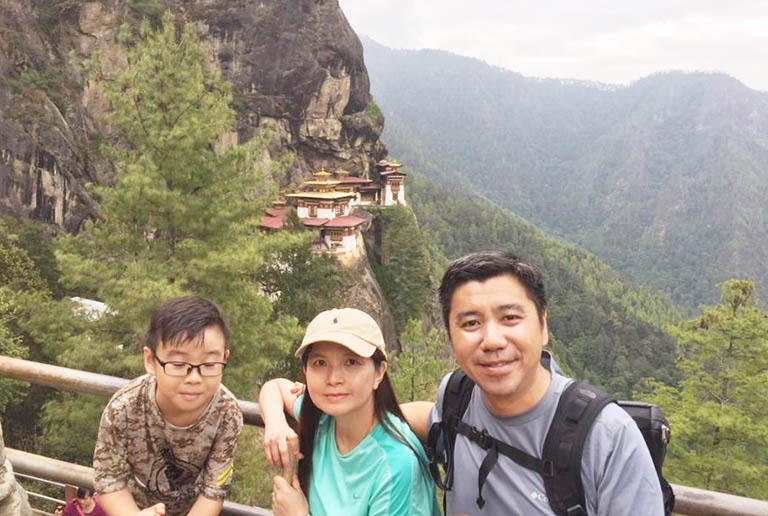
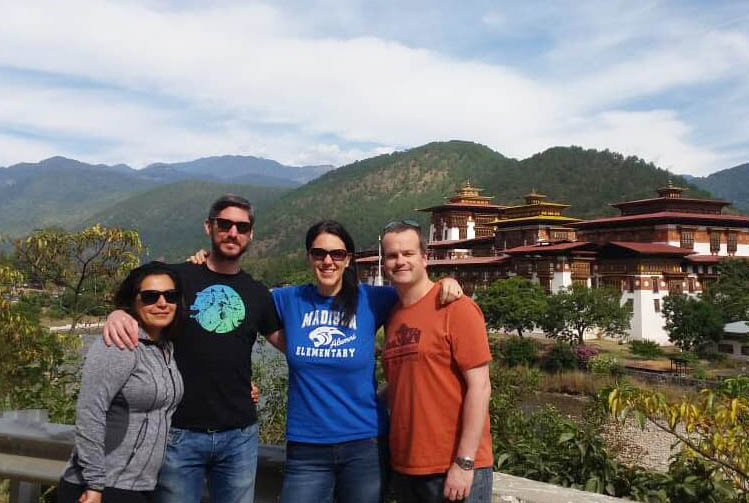
Our dear guests visiting Bhutan
Bhutan Travel Guide
Most Recommended Bhutan Tour Packages
Following are 3 most recommended Bhutan tour packages that you may be interested in. All tour packages are customizable to meet your personal requirements. You can also contact us to customize a trip if you want.
-

-

-

9 Days Bhutan In-depth Natural and Cultural Tour
Paro / Thimphu / Punakha / Phobjikha / Trongsa / Bumthang / Wangue Phodrang / Paro

